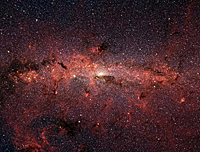Black Holes, Ripples and Galaxies, Oh My!
Double nucleus galaxies cause rare phenomena in black holes and the space-time continuum.
 |
The central white patch in the image is the dense star cluster at the center of our galaxy.
Courtesy of NASA/JPL-Caltech/S. Stolovy (SSC/Caltech) |
It may sound like science fiction, but freakish galactic
events such as ravenous black holes and ripples in the space-time
continuum, could be happening all around us according to new research
from Swinburne University of Technology.
In a study published in the Monthly Notices of the Royal Astronomical Society, Swinburne researchers examined 50 regular galaxies to determine their composition and structure.The
researchers, Alister Graham and Lee Spitler, found that 12 of these
galaxies contained a double nucleus — that is they had both a
super massive black hole and a dense star cluster containing up to ten
million stars at their center.
Traditionally astronomers believed that most small
galaxies had a compact star cluster at their center while giant galaxies
had a super massive black hole. Double nucleus galaxies were thought to
be extremely rare; however the Swinburne researchers have shown that
they are actually quite common.
According to Graham, the prevalence of double nucleus
galaxies significantly increases the likelihood of several bizarre
astronomical phenomena occurring. The first of these is a phenomenon
where black holes ‘eat up’ nearby stars.
“When stars get too close to massive black holes, the
gravitational attraction is such that they can be devoured,” Graham
said. “When you’ve got up to a million stars within the immediate
vicinity of a black hole, the chance of this occurring increases
significantly.”
The predominance of double nucleus galaxies also means
there are likely to be many more ‘hyper velocity stars’ in existence
than astronomers had thought.
“This is when a star approaches a massive black hole
and gets caught in a gravitational slingshot. When this happens stars
can be ejected from galaxies at speeds in excess of 500 kilometers per
second,” Graham said.
Another implication of the research — and
according to the researchers one of the most exciting — is the
increased likelihood of the phenomenon known as gravitational
radiation.
“Such emission has been predicted by Einstein’s
General Theory of Relativity, but has never been observed,” said
Spitler. “It is theorized that when stars spiral quickly around a black
hole the motion will create gravitational waves – causing ripples in the
space-time continuum.”
The Laser Interferometer Space Antenna
(LISA) — a suite of three satellites spaced five million
kilometers apart and planned for launch in 2018 — is being
designed to search for such ripples as they pass through our solar
system.
While the Swinburne research has greatly increased the
chance of observing some of the more bizarre events in our universe, it
also has some immediate consequences for astronomers.
“As part of our study we were able to look at star
clusters and black holes and determine their mass in proportion to each
other and their host galaxies,” Graham said.
“This knowledge is going to affect the way astronomers develop models for galaxy formation and evolution.”
“Previously evolution models only dealt with one type
of nucleus per galaxy. We now have the rationale and data to develop
hybrid models that can account for co-existing nuclei and hopefully
explore their dynamic joint evolution.”